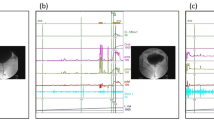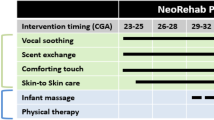Abstract
Achievement of urinary continence is an important developmental step that most children attain with the assistance of their parents and caregivers. Debate continues as to the best time to toilet train; in some Asian and African cultures children are trained as infants, while training at age 2–3 years is more typical in Western cultures. Infant voiding is not merely a spinal reflex, as the sensation of bladder filling is relayed to the brain. However, the ability of the brain to inhibit bladder contractions, and to achieve coordinated bladder contraction with sphincter relaxation, matures over time. While there is a concern that later toilet training may be responsible for an increase in urinary incontinence in children, no controlled studies on early versus late toilet training exist to evaluate this hypothesis. A number of medical conditions such as spina bifida, posterior urethral valves, cerebral palsy and autism can cause incontinence and difficulties in toilet training. The decision to start toilet training a child should take into account both the parents' expectation of how independent the child will be in terms of toileting, and the child's developmental readiness, so that a realistic time course for toilet training can be implemented.
Key Points
-
While an infant can be trained to control voiding, independent toileting is usually achieved in children aged between 2 and 4 years
-
Animal and human studies suggest that bladder emptying is regulated by the brain from the time of birth
-
Significant changes in a child's bladder and sphincter function occur at approximately 18 months of age
-
No prospective clinical study has compared the effects of early versus late toilet training
-
A number of medical disorders can cause difficulty in achieving urinary continence; management may include behavioral therapy or anticholinergic drugs
This is a preview of subscription content, access via your institution
Access options
Subscribe to this journal
Receive 12 print issues and online access
$209.00 per year
only $17.42 per issue
Buy this article
- Purchase on Springer Link
- Instant access to full article PDF
Prices may be subject to local taxes which are calculated during checkout
Similar content being viewed by others

References
Gorski, P. A. Toilet training guidelines: parents—the role of parents in toilet training. Pediatrics 103, 1362–1363 (1999).
Gorski, P. A. Toilet training guidelines: clinicians—the role of the clinician in toilet training. Pediatrics 103, 1364–1366 (1999).
Gorski, P. A. Toilet training guidelines: day care providers—the role of the day care provider in toilet training. Pediatrics 103, 1367–1368 (1999).
American Academy of Pediatrics Toilet Training Q&A. http://www.aap.org/publiced/BR_ToiletTrain.htm (2009).
Milson, I. et al. in Incontinence 4th edn (ed. Abrams, P. et al.) 35–111 (Health Publication Ltd, Paris, 2009).
Boucke, L. Infant potty training: a gentle and primeval method adapted to modern living (White-Boucke, Lafayette, 2008).
Brazleton, T. B. A child oriented approach to toilet training. Pediatrics 29, 121–128 (1962).
Bakker, E. & Wyndaele, J. J. Changes in the toilet training of children during the last 60 years: the cause of an increase in lower urinary tract dysfunction? BJU Int. 86, 248–252 (2000).
Accardo, P. Who's training whom? J. Pediatr. 149, 151–152 (2006).
Kiddoo, D. et al. Evidence report/technology assessment No. 147. The effectiveness of different methods of toilet training for bowel and bladder control. AHRQ publication No. 07-E003 (Agency for Healthcare Research and Quality, Rockville, MD, 2006).
Foxx, R. M. & Azrin, N. H. Toilet training the retarded: a rapid program for day and nighttime independent toileting. (Research Press, Champaign, IL, 1974).
Jansson, U. B., Hanson, M., Sillen, U. & Hellstrom, A. L. Voiding pattern and acquisition of bladder control from birth to age 6 years—a longitudinal study. J. Urol. 174, 289–293 (2005).
Largo, R. H. & Stutzle, W. Longitudinal study of bowel and bladder control by day and at night in the first six years of life. I: epidemiology and interrelations between bowel and bladder control. Devel. Med. Child Neurol. 19, 598–606 (1977).
Largo, R. H. & Stutzle, W. Longitudinal study of bowel and bladder control by day and at night in the first six years of life. II: The role of potty training and the child's initiative. Devel. Med. Child Neurol. 19, 607–613 (1977).
Largo, R. H., Molinari, L., von Siebenthal, K. & Wolfenberger, U. Does a profound change in toilet-training affect development of bowel and bladder control? Devel. Med. Child Neurol. 38, 1106–1116 (1996).
Oppel, W. C., Harper, P. A. & Rider, R. V. The age of attaining bladder control. Pediatrics 42, 614–626 (1968).
Blum, N. J., Taubman, B. & Nemeth, N. Relationship between age at initiation of toilet training and duration of training: a prospective study. Pediatrics 111, 810–814 (2003).
deVries, M. W. & deVries, M. R. Cultural relativity of toilet training readiness: a perspective from East Africa. Pediatrics 60, 170–177 (1977).
Duong, T. H., Jansson, U. B., Holmdahl, G., Sillen, U. & Hellstrom, A. L. Development of bladder control in the first year of life in children who are potty trained early. J. Pediatr. Urol. doi: 10.1016/jpurol.2009.11.002.
Schum, T. R. et al. Sequential acquisition of toilet-training skills: a descriptive study of gender and age differences in normal children. Pediatrics 109, e48 (2002).
Largo, R. H., Molinari, L., von Siebenthal, K. & Wolfensberger, U. Development of bladder and bowel control: significance of prematurity, perinatal risk factors, psychomotor development and gender. Eur. J. Pediatr. 158, 115–122 (1999).
Schonwald, A., Sherritt, L., Stadtler, A. & Bridgemohan, C. Factors associated with difficult toilet training. Pediatrics 113, 1753–1757 (2004).
Blum, N. J., Taubman, B. & Nemeth, N. Why is toilet training occurring at older ages? A study of factors associated with later training. J. Pediatr. 145, 107–111 (2004).
Gladh, G., Persson, D., Mattsson, S. & Lindstrom, S. Voiding patterns in healthy newborns. Neurourol. Urodyn. 19, 177–184 (2000).
Sillen, U. Bladder function in healthy neonates and its development during infancy. J. Urol. 166, 2376–2381 (2001).
Yeung, C. K. et al. Some new insights into bladder function in infancy. Br. J. Urol. 76, 235–240 (1995).
Yeung, C. K., Godley, M. L., Dhillon, H. K., Duffy, P. G. & Ransley, P. G. Urodynamic patterns in infants with normal lower urinary tracts or primary vesico-ureteric reflux. Br. J. Urol. 81, 461–467 (1998).
Bachelard, M. et al. Urodynamic pattern in asymptomatic infants: siblings of children with vesicoureteral reflux. J. Urol. 162, 1733–1738 (1999).
Capek, K. & Jelinek, J. The development of the control of water metabolism: I. The excretion of urine in young rats. Physiol. Bohemoslov. 5, 91–96 (1956).
Maggi, C. A., Santicioli, P. & Meli, A. Postnatal development of micturition reflex in rats. Am. J. Physiol. 250, R926–R931 (1986).
Kruse, M. N. & de Groat, W. C. Micturition reflexes in decerebrate and spinalized neonatal rats. Am. J. Physiol. 258, R1508–R1511 (1990).
de Groat, W. C. et al. Developmental and injury induced plasticity in the micturition reflex pathway. Behav. Brain Res. 92, 127–140 (1998).
Araki, I. & de Groat, W. C. Developmental synaptic depression underlying reorganization of visceral reflex pathways in the spinal cord. J. Neurosci. 17, 8402–8407 (1997).
de Groat, W. C. Plasticity of bladder reflex pathways during postnatal development. Physiol. Behav. 77, 689–692 (2002).
Wu, H. Y. & de Groat, W. C. Maternal separation uncouples reflex from spontaneous voiding in rat pups. J. Urol. 175, 1148–1151 (2006).
Ng, Y. K., Wu, H. Y., Lee, K. H. & Yeung, C. K. Bladder reduction surgery accelerates the appearance of spontaneous voiding in neonatal rats. J. Urol. 183, 370–377 (2010).
Boehm, J. J. & Haynes, J. L. Bacteriology of “midstream catch” urines. Am. J. Dis. Child 111, 366–369 (1966).
Vollmer, H. A new reflex in young infants. AMA J. Dis. Child. 95, 481–484 (1958).
Zderic, S. A. et al. Developmental aspects of bladder contractile function: sensitivity to extracellular calcium. Pharmacology 43, 61–68 (1991).
Zderic, S. A. et al. Developmental aspects of bladder contractile function: evidence for an intracellular calcium pool. J. Urol. 150, 623–625 (1993).
Zderic, S. A. et al. Developmental aspects of excitation contraction coupling of rabbit bladder smooth muscle. J. Urol. 152, 679–681 (1994).
Wu, H. Y., Zderic, S. A., Wein, A. J. & Chacko, S. Decrease in maximal force generation in the neonatal mouse bladder corresponds to shift in myosin heavy chain isoform composition. J. Urol. 171, 841–844 (2004).
Szell, E. A., Somogyi, G. T., de Groat, W. C. & Szigeti, G. P. Developmental changes in spontaneous smooth muscle activity in the neonatal rat urinary bladder. Am. J. Physiol. Regul. Integr. Comp. Physiol. 285, R809–R816 (2003).
Ng, Y. K., de Groat, W. C. & Wu, H. Y. Smooth muscle and neural mechanisms contributing to the down-regulation of neonatal rat spontaneous bladder contractions during postnatal development. Am. J. Physiol. Regul. Integr. Comp. Physiol. 292, R2100–R2112 (2007).
Bakker, E., van Gool, J. D., van Sprundel, M., van der Auwera, C. & Wyndaele, J. J. Results of a questionnaire evaluating the effects of different methods of toilet training on achieving bladder control. BJU Int. 90, 456–461 (2002).
Joinson, C. et al. A prospective study of age at initiation of toilet training and subsequent daytime bladder control in school-age children. J. Dev. Behav. Pediatr. 30, 385–393 (2009).
Tekgul, S. et al. in Incontinence 4th edn (ed. Abrams, P. et al.) 701–792 (Health Publication Ltd, Paris, 2009).
Hellstrom, A. L. Influence of potty training habits on dysfunctional bladder in children. Lancet 356, 1787 (2000).
Park, J. M., Bloom, D. A. & Mcguire, E. J. The guarding reflex revisited. Br. J. Urol. 80, 940–945 (1997).
Vermandel, A., van Kampen, M., van Gorp, C. & Wyndaele, J. J. How to toilet train healthy children? A review of the literature. Neurourol. Urodyn. 27, 162–166 (2008).
Fitzgerald, M. P. et al. Childhood urinary symptoms predict adult overactive bladder symptoms. J. Urol. 175, 989–993 (2006).
Minassian, V. A., Lovatsis, D., Pascali, D., Alarab, M. & Drutz, H. P. Effect of childhood dysfunctional voiding on urinary incontinence in adult women. Obstet. Gynecol. 107, 1247–1251 (2006).
Iddon, J. L., Morgan, D. J. R., Loveday, C., Sahakian, B. J. & Pickard, J. Neuropsychological profile of young adults with spina bifida with or without hydrocephalus. J. Neurol. Neurosurg. Psychiatry 75, 1112–1118 (2004).
Smith, G. H., Canning, D. A., Schulman, S. L., Snyder, H. M. III & Duckett, J. W. The long-term outcome of posterior urethral valves treated with primary valve ablation and observation. J. Urol. 155, 1730–1734 (1996).
Koff, S. A., Mutabagani, K. H. & Jayanthi, R. The valve bladder syndrome: pathophysiology and treatment with nocturnal bladder emptying. J. Urol. 167, 291–297 (2002).
Decter, R. M. et al. Urodynamic assessment of children with cerebral palsy. J. Urol. 138, 1110–1112 (1987).
Silva, J. A. F., Alvares, R. A., Barboza, A. L. & Monteiro, R. T. M. Lower urinary tract dysfunction in children with cerebral palsy. Neurourol. Urodyn. 28, 959–963 (2009).
Acknowledgements
Charles P. Vega, University of California, Irvine, CA, is the author of and is solely responsible for the content of the learning objectives, questions and answers of the MedscapeCME-accredited continuing medical education activity associated with this article.
Author information
Authors and Affiliations
Ethics declarations
Competing interests
The author declares no competing financial interests.
Rights and permissions
About this article
Cite this article
Wu, HY. Achieving urinary continence in children. Nat Rev Urol 7, 371–377 (2010). https://doi.org/10.1038/nrurol.2010.78
Published:
Issue Date:
DOI: https://doi.org/10.1038/nrurol.2010.78
This article is cited by
-
Disposable diaper overuse is associated with primary enuresis in children
Scientific Reports (2020)
-
Pilotstudie zum Trink- und Entleerungsmanagement in Kindertagesbetreuungseinrichtungen im Landkreis Garmisch-Partenkirchen
Der Urologe (2019)
-
Toilet training in daycare centers in Flanders, Belgium
European Journal of Pediatrics (2012)


